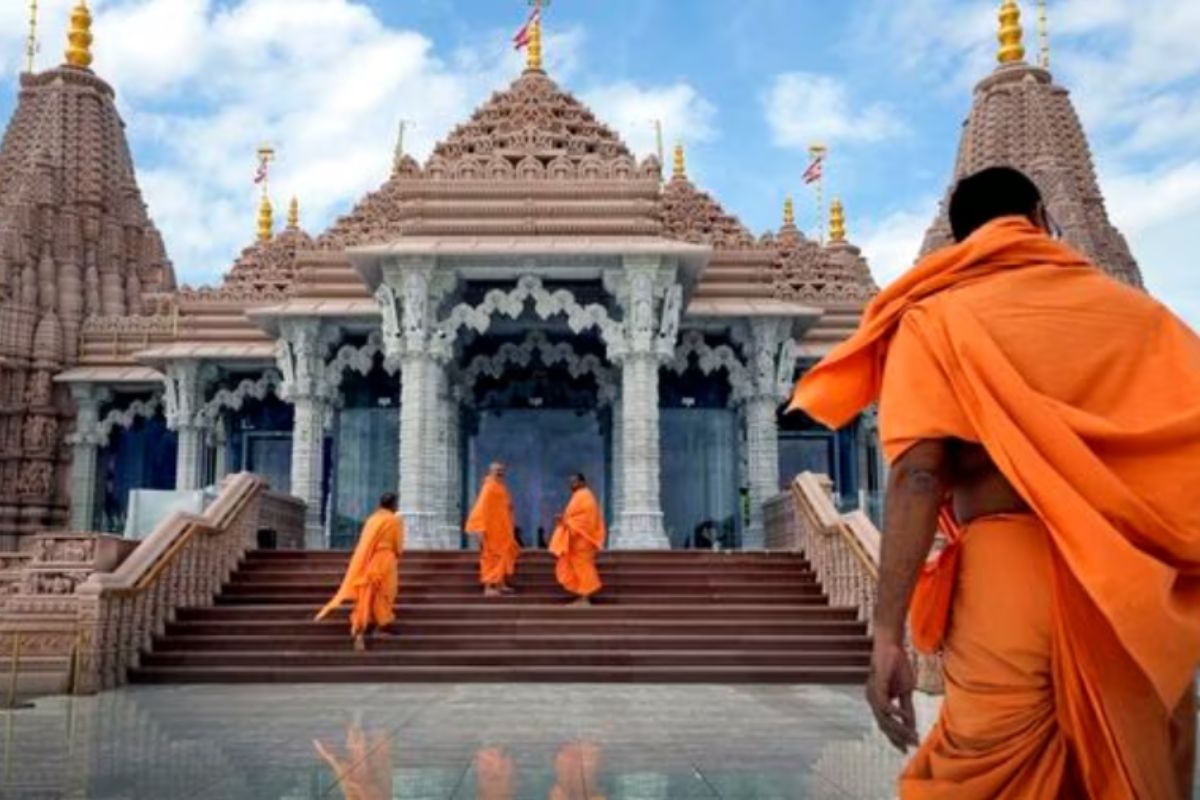


NEW DELHI: Prime Minister Narendra Modi is set to unveil a Hindu temple in Abu Dhabi, UAE on Thursday. The BAPS temple, renowned for its architectural grandeur, has received contributions from various regions of India.
Back in October 2022, Dubai’s Temple was inaugurated by UAE Minister of Tolerance, HH Sheikh Nahyan bin Mubarak Al Nahyan.
So, how does the temple look from inside?
The temple comprises seven sanctuaries, each dedicated to various Indian deities representing different regions of the country. These include Lord Ayyappa, Lord Tirupati Balaji, Lord Jagannath, Lord Krishna and Radha, Lord Hanuman, Lord Shiva and Parvati along with their children Ganesh and Karthik, and Lord Ram and Sita.
Also Read: PM Modi to inaugurate BAPS temple in UAE: Top agenda
Intricate carvings illustrating the life and teachings of these deities embellish each sanctuary. At the entrance of the temple, eight idols symbolise the fundamental values of Sanatan Dharma.
The Dome of Unity exhibits representations of the five natural elements: water, fire, air, earth, and space. Carvings of local animals like horses and camels, emblematic of the UAE, adorn the structure. Moreover, the Wall of Unity, among the UAE’s largest 3D-printed walls, displays a video highlighting significant phases in the temple’s construction.
As per temple officials, an amphitheatre resembling a ghat has been constructed on the waterfront side, mimicking the ghats of Varanasi where the Ganges flows. The intention is to provide visitors with a reminiscent experience of the ghats in India, allowing them to sit and meditate.
Upon entering, visitors will see two water streams symbolising the Ganges and Yamuna rivers in India. A beam of light representing, the Saraswati River, will also emanate from the temple structure, forming the ‘Triveni’ Sangam.
The temple received recognition as the Best Mechanical Project of the Year 2019 at the MEP Middle East Awards, as well as the Best Interior Design Concept of the Year 2020.
Along the pathway to the temple, approximately 96 bells and gaumukhs are positioned. These 96 bells serve as a commemoration of Pramukh Swami Maharaj’s 96 years of life. Nano tiles have been used for the flooring, ensuring comfort for visitors even in hot weather conditions.
His Holiness Mahant Swami Maharaj inaugurated the Pramukh Sabhagruh assembly hall of the #AbuDhabiMandir by performing his morning pooja in the presence of swamis and devotees. pic.twitter.com/SemLbyA7Gw
— BAPS Hindu Mandir (@AbuDhabiMandir) February 11, 2024
At the upper left corner of the temple, there is a stone carving depicting the moment when Pramukh Swami Maharaj envisioned the Abu Dhabi temple in 1997. Over 350 sensors have been affixed to the mandir, with an additional 100 sensors placed in the foundation. These sensors are tasked with gathering data on temperature variations, alterations in pressure, and seismic movements.
In addition to 15 narratives from Indian civilisation, the temple showcases tales from a diverse range of cultures including the Maya, Aztec, Egyptian, Arabic, European, Chinese, and African civilisations.
His Holiness Mahant Swami Maharaj Accorded Traditional Arabic ‘State Guest’ Welcome, Abu Dhabi, UAE https://t.co/TvjrK3Lm3B pic.twitter.com/VixII8hteP
— BAPS (@BAPS) February 6, 2024
The temple construction adheres to the ancient Hindu ‘shilpashastras’. Its exterior features pink sandstone sourced from Rajasthan, while the interior is adorned with white marble. Crafted by over 2,000 artisans from Gujarat and Rajasthan, the white marble pillars showcase intricate designs of peacocks, horses, elephants, camels, and moons.
The compound comprises a visitor’s centre, prayer halls, exhibition spaces, educational zones, recreational areas for children and youth, themed gardens, water elements, a food court, bookstore, gift shop, and various amenities.
His Holiness Mahant Swami Maharaj, the spiritual leader of BAPS arrives at the BAPS Hindu Mandir, Abu Dhabi marking the beginning of the Festival of Harmony #FOHabudhabi #AbuDhabiMandir #FestivalofHarmony #Love #Peace #harmony pic.twitter.com/qWPdfuF2iy
— BAPS Hindu Mandir (@AbuDhabiMandir) February 5, 2024
Sadhu Brahmaviharidas has elucidated the intricate symbolism embedded within the temple’s architectural design. With its seven spires, the Mandir serves as a testament to the appreciation for the unity among the seven emirates, symbolising the harmonious bond between India and the UAE. Moreover, the seven spires serve as a tribute to seven significant deities, emphasising the interconnectedness of various cultures and religions.
Also Read: All you need to know about BAPS Hindu Temple Complex in Abu Dhabi
“Typically, our temples feature either one, three, or five spires, but here, the presence of seven spires signifies our gratitude towards the unity of the seven emirates. Simultaneously, these spires represent the reverence for seven important deities,” he articulated.
BAPS stands for Bochasanwasi Shri Akshar Purushottam Swaminarayan Sanstha, which embodies a socio-spiritual Hindu belief system grounded in the Vedas. It was initiated by Bhagwan Swaminarayan (1781-1830) in the late 18th century and officially founded in 1907 by Shastriji Maharaj (1865-1951), as stated on its website.
BAPS is founded on the tenets of applied spirituality, tackling spiritual, ethical, and societal issues. Spanning a worldwide network of 3,500 centres, BAPS has garnered recognition through national and international accolades, including affiliations with the UN.
#MandirMoods pic.twitter.com/P1fHTZJNCc
— BAPS Hindu Mandir (@AbuDhabiMandir) February 3, 2024
During Prime Minister Modi’s visit to the Gulf nation in 2015, the UAE granted land for the construction of a temple in Abu Dhabi. This visit carried considerable diplomatic significance, marking Modi as the first Indian Prime Minister to visit this strategically important Gulf nation in 34 years, following Indira Gandhi’s visit.
Reports indicate that Modi extended gratitude to the UAE leadership on behalf of 1.25 billion Indians for their decision to erect the temple, lauding it as a “historic” decision.